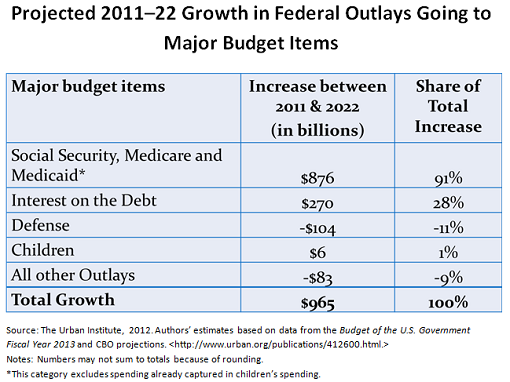The Budget Crunch for Children—An Update
Posted: July 19, 2012 Filed under: Children, Columns, Taxes and Budget 1 Comment »The Urban Institute recently released Kids’ Share 2012: Report on Federal Expenditures on Children through 2011, by Julia Isaacs, Katherine Toran, Heather Hahn, Karina Fortuny, and myself. It looks comprehensively at trends in federal spending and tax expenditures on children over the past 50 years. This sixth annual report is well worth a look if you are at all interested in how children fare in the federal budget.
In 2011, federal outlays on children fell by $2 billion, dropping from $378 billion in 2010 to $376 billion in 2011. This is the first time spending on children has fallen since the early 1980s.
However, children’s share of the spending has gone up and down over the last fifty years. Federal budget outlays on children as a percent of the domestic budget have declined from 20 percent in 1960 to 15 percent in 2011. Spending on children has not kept pace with growth in government spending over the last fifty years.
In the future, spending on children is expected to further decline, driven by budget pressures, which are strongest on the very types of programs on which kids rely: domestic discretionary programs like education that, unlike entitlements, do not grow automatically but require congressional funding each year. From 2011 to 2022, federal outlays are projected to grow by almost $1 trillion, but children gain almost nothing from this growth. In comparison, the nonchild portions of Social Security, Medicare, and Medicaid are projected to claim 91 percent of the increase.
As a result, children’s spending is projected to fall sharply as a share of the economy, from 2.5 percent of GDP in 2011 to 1.9 percent in 2022, below pre-recession levels. In 2017, Washington will start spending more on interest payments than on children.
Future decreased investment in children can be compared to increased investment on seniors. Their starting points are also different: in per-person terms in 2008, the federal government spent $3,822 on children and $26,355 on the elderly (in 2011 dollars). Take into account state and local spending, and a child on average still only gets about 45 percent as much as an elderly person.
The decrease in emphasis on children is part of a broader worrying trend that increasingly crimps investment, budgetary flexibility, and choices for the future.



[…] Gene Steuerle. This entry was posted in Uncategorized by gateway. Bookmark the […]